It has taken us 25 days and 900 km to get here, but we are finally in Cuxhaven, Germany at the start of the Elberadweg, or Elbe Bike Route, the centerpiece of this year's adventure. We made our way from the hotel back to the Kugelbake, the marker which tells ships when they've gone from the Elbe to the North Sea. Jeff is pointing, more or less, towards our destination of Prague, reportedly 1,000 km upstream. Off we go!
Our route is mostly following dikes, which give you a good view when you get on top, though perhaps not quite as good a view as in this lighthouse. It surprised us at first to see it inside the dike, but then that makes sense, protecting it from storms coming across the North Sea. Although we're technically on our way up the river, it's a very wide bay right here, a few kilometers across.
As we get ready to leave the lighthouse, we have a choice of routes: on the land side of the dikes, or the river side with the sheep. We chose the river side for the view but soon found ourselves dodging sheep droppings galore. At the gate we even had a welcoming committee. The sheep do a good job of turning grass into wool sweaters and/or lamb chops and make cutting the grass a thing of the past, but those gates every km or two are a nuisance since each one requires Louise to hop off to open it as Jeff pushes the tandem through. In this instance, it also gave Louise a chance to check out the "sheep dip" on her legs following our slalom ride through the sheep droppings. We're leaning more toward lamb chops than sweaters this morning.
About 100 km from Cuxhaven we come to the quaintest town we've seen yet in this part of Germany, the small Hanseatic city of Stade. We probably would have booked a night here to get a fuller look, but we are on a schedule to get to a dentist on Thursday afternoon to fix Jeff's broken molar, so we only stayed long enough for a few photos, including one of a woman in 19th century German dress who seems oblivious to the "Thai-Sushi" restaurant behind her.
The theme for our 3-night stay in Hamburg was art, high and low. The first of our two off-the-bike days was spent in the Hamburger Kunsthalle, one of the larger art museums in the country. There was a large collection from the Golden Age of Dutch art, including this wonderful winter scene by Joos de Momper the Younger.
 One of the most important paintings they've acquired in recent years is this iconic Romantic image called Wanderer Above the Sea of Fog by Caspar David Friedrich.
One of the most important paintings they've acquired in recent years is this iconic Romantic image called Wanderer Above the Sea of Fog by Caspar David Friedrich.Of the many Impressionist works, we chose two to show you, a very large Renoir called Riding in the Bois de Boulogne, and a close-up from a Toulouse-Lautrec gouache and chalk sketch on paper for its use of color, something the Impressionists were masters at. We don't think we've ever seen a person with green skin, but somehow the green under the woman's chin works. Maybe our artist friend in Seattle, Tamara, can explain to us someday why that's so.

We'll close our foray into fine art with an evocative Edvard Munch, Girls on a Bridge, painted in 1901. In our grumpy view of art, that's about when visual artists lost their collective souls, or perhaps their minds, so we'll not bother with the next several galleries of modern art in the museum.
It was now time for art of a very different type, the popular art of the Miniatur Wunderland. The setting is two floors of a very large warehouse in a district full of very large warehouses, many of which are probably not as full as they could or should be.
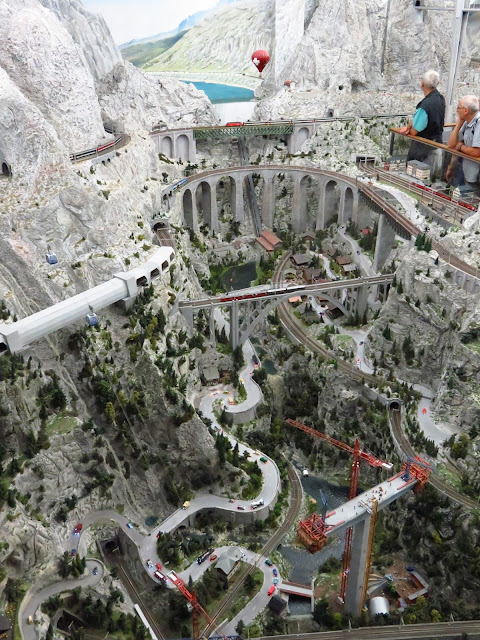 And what a wonderland they have created! They are still working on new sections, and they are now approaching 20 km -- yes, 20,000 meters -- of train tracks, all interconnected over two floors. They say it's the largest model train display in the world, and we don't doubt them. Different sections represent different parts of Germany or of other countries. Here, for example, are two views from the Switzerland layout, with trains going by every few minutes on too many different tracks to keep track of.
And what a wonderland they have created! They are still working on new sections, and they are now approaching 20 km -- yes, 20,000 meters -- of train tracks, all interconnected over two floors. They say it's the largest model train display in the world, and we don't doubt them. Different sections represent different parts of Germany or of other countries. Here, for example, are two views from the Switzerland layout, with trains going by every few minutes on too many different tracks to keep track of.How big are the people and trains? Pretty darned small, as you can see when this fellow popped out of the ground to do a small repair. The scale is 1:87, so if the guy doing the track work wanted to step into the scene as a character, he'd have to shrink down to 3/4 of an inch tall.
The activity and the detail is amazing. Not only do trains move, but also cars, buses, chair lifts, and many of the little people -- press a button and one guy chops down a tree! In a model of the new concert hall opening next January, the conductor conducts and the musicians move their arms and bodies as Finlandia plays in the background. At last count there were over a quarter of a million "people" in the exhibit, and we never found two exactly alike.
There is also tremendous humor throughout. Here are two examples: a kid coming out of an outhouse with toilet paper streaming after him, and a field of sunflowers being harvested as a couple make out on a blanket at the bottom left (sorry, that one wasn't animated).
Then there was the crash on a mountain stage of the Tour de France. Hey, is that someone about to throw his bike over the railing?!
Few of the scenes are meant to be exact reproductions of anywhere specific, but rather pick up "themes" or feelings about a place. Knowing this, we were anxious to see what was portrayed in the "America" area. Here are a few highlights -- a Wild West town with a fight on the balcony of a saloon, but also a hot dog stand and a CNN truck; a gold mine in California; an automobile graveyard in the desert; and a plane crash somewhere in the canyonlands of the SW.
In addition to the enormous interconnected and international display, there were several glass-enclosed exhibits downstairs that activated the historical gene in us. There were 7 or 8 iterations of the same archetypal town at different times in its history. The glare from the glass is a little annoying, but perhaps you can still see a lot. First the early Middle Ages with a castle, a few homes, and farms across the river. Then the Baroque era (note the redecoration of the castle). Next, the 19th century with its fake gothic remake of the castle and a train line now tunneling under it. Lastly, during the middle of WWII with castle turned into anti-aircraft battery and the factory a victim of an earlier Allied bombing attack. It's so easy to think of places and things as more or less permanent and unchanging, and displays like this are a wonderful aid to imagining other times and realities.
We left Hamburg relaxed and refreshed, mentally and physically, and headed on upstream. Upstream here is mostly to the southeast, and we continued to have a NW tailwind behind us as we have since we started in Holland weeks ago. How much longer can we be so lucky? We had a variety of road types, all remarkably rural once we got just a few km from the airbnb apartment we had rented in Hamburg.
And then we came to something from German history that was not miniature and charming but all too real and oh, so sad -- the Neuengamme Concentration Camp Memorial.
It exists mainly because the buildings continued to be used after the war, first to house the sorts of criminals who had run places like this, such as SS officers and Nazi officials. Then it became a prison for ordinary criminals. That eventually ended, and a reawaked desire within Germany to keep the past from being forgotten led to the creation of the memorial.
The brick building you see was built to house 500 prisoners but soon had twice that. A triple bunk had 2 or 3 people crammed onto each mattress, making sleep close to impossible. The large rectangles in front of the brick building mark where there were once wooden bunkhouses, cookhouses and the like, with conditions usually even worse.
This was not a death camp, and few people were murdered in cold blood, but rather by overwork, poor nutrition, dismal hygiene and the like. It was opened as a concentration camp for "enemies of the state," mostly socialists and homosexuals with some Roma, Sinti and Jews soon joining them. During the war, it mostly held POWs, especially from Russia. Over 100,000 people were prisoners at one time or another.
The building is now deceivingly spacious inside, and exhibits did not dwell on the horrors so much as celebrate those who lived and died there. There were hundreds of notebooks, each one personalizing an individual who was imprisoned there -- how old, why the Nazis imprisoned them, what their fate was. Many were in fact survivors, some still alive. Photos made even those who did not survive seem alive to us as persons, not just statistics.
The next morning we were faced with our most challenging stretch of cycling yet as the Elberadweg went up and over a series of hills on what are euphemistically referred to as "forest roads." Our tires are 1.75 inches (45 mm) wide, and were up to the task, but it was still teeth-chatteringly bumpy.
There was a reward, however, when we reached views over the Elbe at Lauenburg, a charming city about 75 km upstream from Hamburg.
The charm continued when we descended the hill to the houses below, with one caveat -- the ancient cobblestones were even bumpier than the forest road had been. You can recreate our trip down the last block to the river by picking up your computer screen and shaking it violently up and down as you view it.








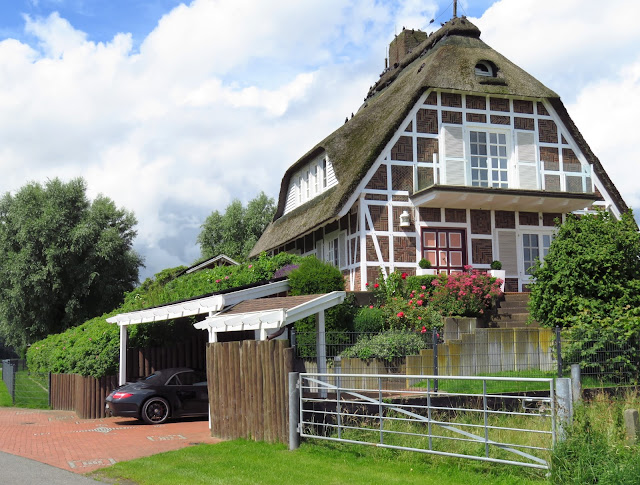
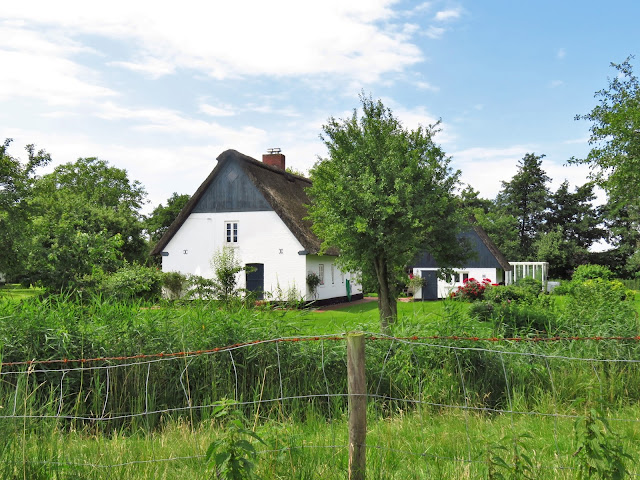































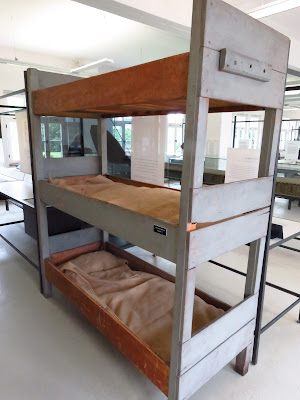

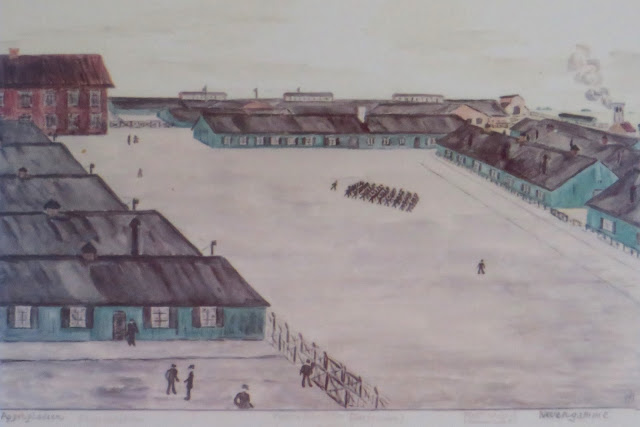







No comments:
Post a Comment